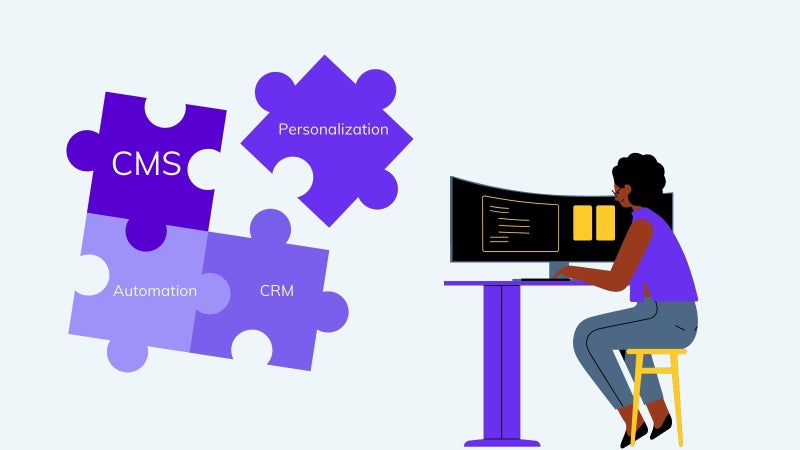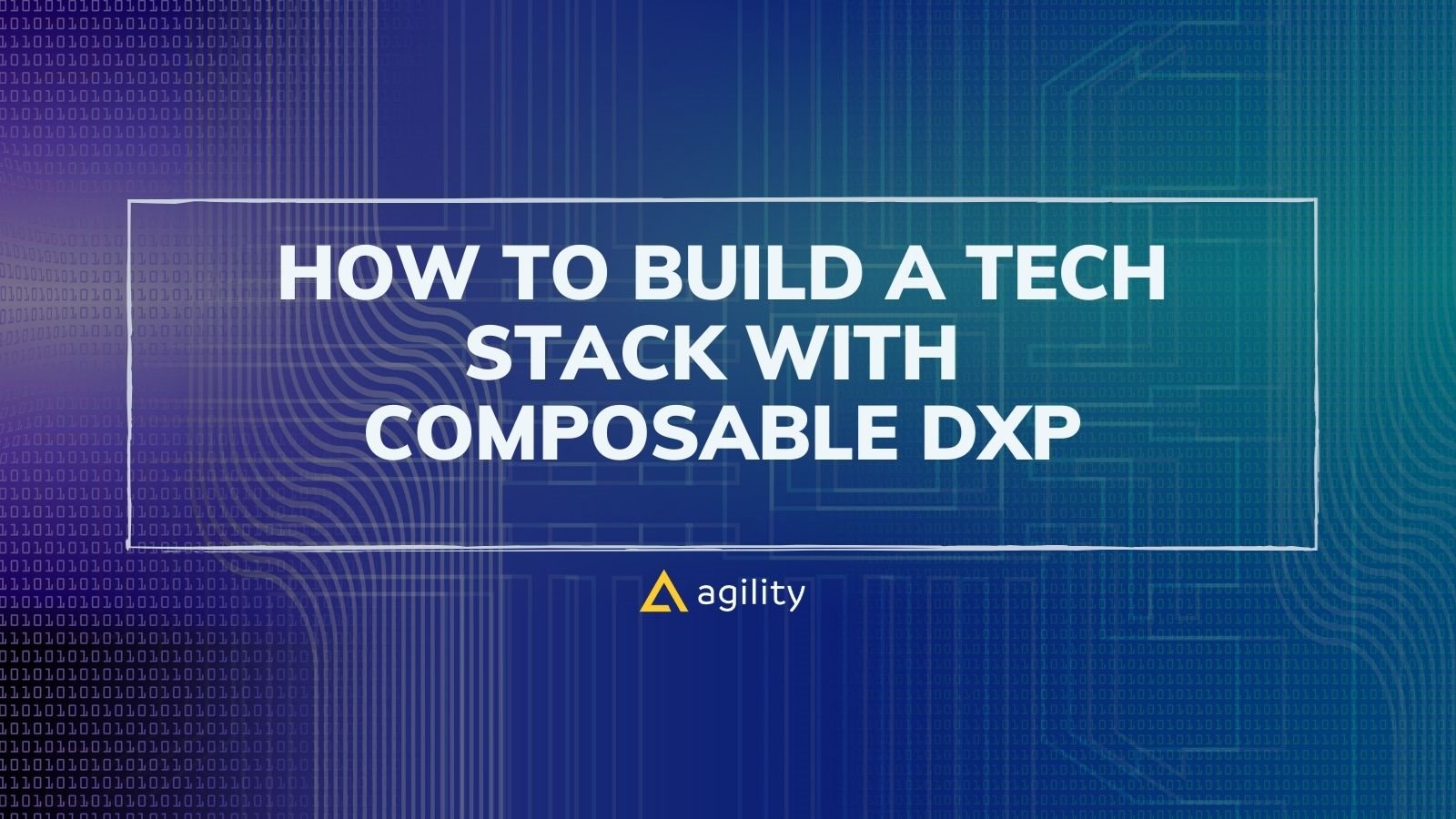DXP lays the framework for a new digital experience. It utilizes many best-of-breed solutions to ensure customers get the best experience in their interaction with a brand’s service or product. It is a dynamic and mind-blowing platform. It optimizes the digital customer journey alongside proper management of content by companies. Composable DXPs cannot be considered an individual product or an item. Rather it is all-encompassing owing to a side-by-side partnership with APIs and other microservices developments.
In an interview with Agility CMS, Douglas Karr explained DXP as a digital experience platform. He said, ‘DXP offers an incredible opportunity to personalize the experience and tailor it to the user. So that you can increase that engagement, increase that conversion rate, and give them the information that they need when they are looking for it.’ The interview is available here. The trend in the world expands daily toward subsuming innovative schemes and platforms. Composable DXP is an excellent example of such an innovative platform.
Over the years, we have had Monolithic DXPs in the orbit of business and marketing. However, unlike the composable DXPs, which hinge upon composability, these Monolithic DXPs could not incorporate all available in the composable DXPs.
Monolithic DXPs do not permit microservices-and-cloud integrated mode to implement a DXP stack. In the interview with Douglas Karr, Joel Varty, President of Agility CMS, said, ‘I think digital experience platform (CMS) represents the full customer journey.’
A composable DXP system provides structure to ensure campaigns and content are managed in a central pivot. A composable DXP system ensures that, as a business owner, the digital segments of your business work together to improve the customer journey.
In the interview, Douglas Karr tells Agility CMS,
‘That composable aspect is really something that I think is just going to skyrocket in growth. And I think you know, Gartner, I think, said, you know, by 2023, 60% of businesses are going to have some composable DSP implementation.
Monolithic DXPs suffer from implementation. In addition, reports state that monolithic solutions impede application leaders' ability to create and launch new experiences. Composable DXPs are easily implemented, used, and customized to align with the company's goals. As a result, prominent application leaders migrate from monolithic DXPs to composable DXPs.
The Importance Of Composable DXPs for Technology Stacks

According to Gartner, ‘by 2023, organizations that have adopted an intelligent composable approach will outpace the competition by 80% in the speed of new feature implementation.’ As a brand operator or executive, this is the right time to adopt an intelligent composable approach to define your customer journey. For more convincing reasons, you can find the importance of Composable DXPs below:
1. Straightforward Customization Setting
The significant importance of composable DXPs is the ease of incorporating changes. Composable DXPs are not repellent to further updates; rather, they are open to shapeshifting into features incorporated by your stack. Monolithic DXPs are not the same. Integration within and without is complex in Monolithic DXPs.
2. Far-flung Content
The headless design allows the delivery of well-arranged and excellent content across various devices—for instance, vehicles, browsers, and many others. The far-flung content is a distinct feature of composable DXPs. As a result, contents are not restricted to a particular channel or device.
3. Deliver Content Faster and Save Time
It is a season of alteration and long-lasting pleasure for swiftness. Countless companies are on the lookout for contextual and conformable digital experiences. Composable DXPs appear the most selectable and profitable. It is not a rigid scheme where content is scarce and stale. Instead, it ensures content is handy and reconditioned as required. There is no doubt about composable DXPs' quick procession of content creation. With composable DXPs, faster content creation is a certainty.
Building A Tech Stack With Composable DXP
A tech stack is not just a mundane dispatch. It is more profound than the superficial inclination of the term’s wordy visage. Some may be acquainted with a tech stack, while others might not. But what is a tech stack?
A tech stack is a weave of technologies deployed by a company to process an application or project. It is a 'solutions stack'. To be precise, a tech stack is a toolbox consisting of a database, front-end and back-end tools, APIs' knitted applications, and programming languages. Tech stacks ensure information about the structure of an application gets disseminated. It personifies a stockpile of systems, programming languages, and aids needed by developers. These structures, aids, and programming languages are hints required by developers. They are fundamental because they help developers understand the body frame of an application. It saves from impending calamities because it unveils the weaknesses and strengths of an application.
Tech stacks define the formidability of an application. It is a summarization of components pertinent to interface with the application. So, if there's a problem with an application, the developer finds the origin via the tech stacks. Every effort to discover the problem will prove futile without the tech stacks. Therefore, it is pretty affirmative why some developers refer to it as a solutions stack. Tech stacks are otherwise known as a data ecosystem that comprises a catalog of technology utilities. Interestingly, these technological utilities are vital to running and building an application.
Tech stacks were much more straightforward than this present stage of all-pervading SaaS services and products. Then, it consisted of restricted source alternatives like WAMP, LAMP- Linux, Apache, MySQL, PHP, and many others. Nonetheless, it is a different and lush tale in the present dispensation. Today, there are many tools at the beckon of product teams and engineers. These tools are not knotty; they offer many more solutions than their forebears. They help to establish and sustain suitable products for their market scope.
For instance, the popular social media, Instagram tech stacks comprise the following technologies:
React Native- iOS & Android apps.
Python (Django framework)
HTML5JavaScript-server-side
Computing services- Amazon S3, EBS, Amazon EC2, Amazon.
Database- PostgreSQL.
Thus, building a tech stack with composable DXP requires that much is taken into fastidious consideration. The modern tech stack structure comprises the following components:
- Frontend Framework- The Client Side
- Backend Framework- Operating Systems and Programming Languages, Data Storage and Querying, Servers and Load Balancing, and Monitoring and Performance Tools - Server Side
- Other Applications- APIs, BI Tools, and Behavioral and User Analytical Tools
A tech stack is influential to the bearing of your company. How your tech stack is set up affects your company in multidimensional ways. It influences the efficacy of your work, the caliber of engineers you will hire, and the kind of products and services you will create. Some of these technologies are quicker than others. Others allow minor customization, while some make a surer audience interface. While some are more scalable than others, others are replete with technologies you could never imagine.
Many companies out there desire an excellent tech stack where the customer journey is optimized and prioritized. Albeit, there are many factors to take into proper consideration.
In his interview with Agility CMS, Douglas Karr said, ‘I mean, ultimately, your business should decide, right? But, no, it is again where I put those three back together, you know, people, processes, and platforms. I’ll give you a crazy one. We worked with a major donation company, private, nonprofit, online, and their entire staff was certified on a certain platform. So guess what happened when they migrated to a new platform? They lost their staff.’ Therefore, company owners must consider building their tech stack with composable DXPs.
Douglas further broached, 'You want to map out where you want to be, you know, from a business aspect, and what you're incapable of doing now because of systems or processes or talent that you have internally. And then you have to itemize out, you know, if we were an organization that could achieve X, you know, here's what it's going to take there. And I think when companies do spend that, I give it in another example; we worked on an implementation for one client. We did an enterprise implementation; it took about six months to do the key to how quickly that was quick. It usually would take a year and a half because it was just massive systems, data migrations, etc. The key to that was that they paid upfront for this discovery phase. That discovery phase enabled us to remove all the roadblocks downstream so that we knew, you know, where the focus was and the ultimate goal, and we stayed on target. We didn't, you know, we didn't sway at all. And, and, and it was good on that company to do that. A lot of companies don't do that. They start with the software license, you know, and then try to work backwards, and that's, that's just it's a recipe for disaster.' There is a discovery phase which gets complemented by the phase of building your tech stack with composable DXPs.
As established earlier, composable DXPs prioritize people-customers, which fits perfectly into what Douglas mentioned in the interview. Check Douglas Karr's interview with Agility CMS here.
In developing a tech stack with composable DXPs, you must consider the MACH ecosystem, a fulcrum for composable businesses. So what is the MACH Ecosystem? It is an acronym for the following components: Microservices Based, API-First, and Headless, of which Agility CMS is a perfect type.
- Microservices Based: It provides a cohort of individually-powered components open to further independent management and development.
- API-First: The functionalities of applications depend on APIs introduced in programming. For instance, Cloud-native permits the substitution of enterprise suites with solid Software as a Service (SaaS) solutions. SaaS provides elastic scaling, durable storage and many other benefits.
- Headless: Headless structure disentangles the front end from back-end serves. It ensures users can publish, keep, sustain and create content from the pivot circuit to other virtual channels.
The above-listed components of composable DXPs are absorbed when you build your tech stack with composable DXPs.
Why you should adopt a composable dxp stack
Composable DXPs are exciting and priceless. With further technological developments, it even might get more exciting and valued as an invaluable digital interaction with customers. Building your tech stack with composable DXPs saves you from an overhaul migration. Instead, it creates room for adding tools to help perform the tasks you desire your tech stack to perform.



